
Normal Vision Eye
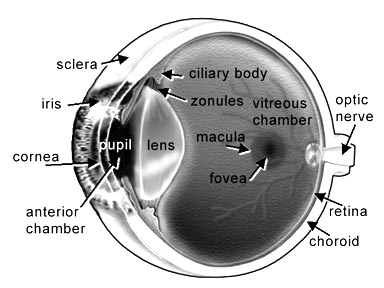 |
|---|
WHAT IS REFRACTIVE ERROR?
"Refractive error" is a term that is used to describe an inability of images to focus properly on the retina of the eye. The goal of glasses, contact lenses and refractive surgery is to correct or improve these errors by helping to focus properly.
The visual disorders (called refractive errors) that require you to wear glasses or contact lenses to correct short-sightedness, long-sightedness or astigmatism are the most common vision problems worldwide. Refractive errors occur when the curve of the cornea (the window of the eye) is irregularly shaped (too steep or too flat) or the eye is too short or too long. When the cornea is of a normal shape and curvature, it bends, or retracts, the light onto the retina with precision. However, when the curve of the cornea is irregularly shaped the cornea bends light imperfectly onto the retina. This affects good vision.
The refractive process is similar to the way a camera take a picture. The cornea and lens in your eye act in the same way as the camera lens. The retina is similar to the film. If the image is not focused properly, the film (or retina) receives a blurry image. The image that your retina sees then goes to your brain, which tells you what the image is.
Refractive surgery is an ophthalmic specialty devoted to correcting refractive errors including myopia (nearsightedness), hyperopia (farsightedness), regular and irregular astigmatism and presbyopia. To understand how refractive procedures work, it is important to understand how eyes with refractive errors and keratoconus differ from the emmetropic or "normal" eye.
The eye is a spherical structure about an inch in diameter. It has a clear bulge on the front side, which is the cornea. The wall of the eye beyond the cornea consists of three tissue layers. The outermost layer is the sclera, a tough, protective coating that covers most of the outer surface of the eye that connects to the transparent cornea at the front of the eye. The middle layer is the choroid, a vascular layer that is continuous with the ciliary body and the iris on the front side of the eye. The inner layer is the retina, a light-sensitive tissue that lines the inside back wall of the eye. To understand how the eye works, it is useful to think of a camera. The human eye is more complex than a television camera, but the principles are similar. Place your cursor on the eye's parts below to see how they function.
Emmetropia is the ideal state of the eye in which no refractive error is present. The focus of the eye is set for distance vision without the need for glasses or contact lenses. Emmetropia occurs when the curvature of the cornea, the shape of the lens and their distances from each other and the retina are in harmony. The cornea and lens focus the rays of light from an object perfectly on the retina, creating a sharp image.
MYOPIA
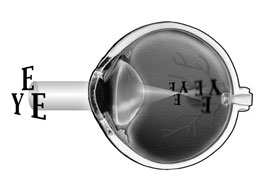 |
|---|
The refractive error known as myopia or short-sightedness occurs when the eye is too long or the cornea is curved too steeply. Far away objects will appear blurry because they are focused in front of the retina. Myopia effects over 25% of all adults.
Myopia, also known as nearsightedness, is a condition in which a person can see near objects more clearly than distant objects. Myopia is usually the result of a larger than normal eye. In the myopic eye, light rays from distant objects focus before they reach the retina. The result is blurred vision. A tendency for myopia may be inherited; frequent or prolonged near work may influence its progression. It is typically detected in school-age children, may worsen during adolescence, and generally stabilizes between the ages of 20 and 40 years of age.
HYPEROPIA
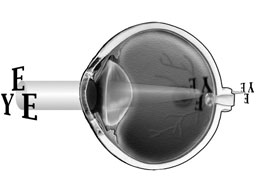 |
|---|
The refractive error known as hyperopia or long-sightedness occurs when the eye is too short or the cornea is too flat. Distant objects are clear, and close-up objects appear blurry. With hyperopia, images focus on a point behind the retina.
Hyperopia, also known as farsightedness, is a condition in which a person can see distant objects more clearly than near objects. Hyperopia usually occurs when an eyeball is smaller than normal. When an eyeball is small, light rays from near objects do not focus properly on the retina at the back of the eye. The result is blurred vision. Hyperopia may be inherited. Babies and young children tend to be slightly hyperopic. As the eye grows and becomes longer, hyperopia lessens. Presbyopia, a condition with similar symptoms, has an entirely different cause that is related to aging.
ASTIGMATISM
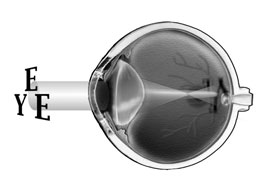 |
|---|
The refractive error known as astigmatism occurs when the cornea is not round like a football but curved more like a rugby ball. The unveven curvature of the cornea blurs and distorts both distant and near objects. The normal cornea is round, with even curves from side to side and top to bottom. With astigmatism, the cornea is shaped more like the back of a spoon, curved in one direction more than the other. This causes light rays to have more than one focal point and focus on two separate areas of the retina, distorting the visual image. Two-thirds of people with myopia also have astigmatism.
Astigmatism is a condition in which objects, both near and distant, appear blurred. The cornea and lens of the eye should be spherical. When one or both are curved more steeply in one meridian than another, the optics take on a toric shape (like a football). This uneven curvature prevents light rays entering the eye from focusing to a single point on the retina, blurring the visual image somewhat like a funhouse mirror at an amusement park. Astigmatism often occurs in combination with myopia and hyperopia.
PRESBYOPIA (NEED FOR READING GLASSES)
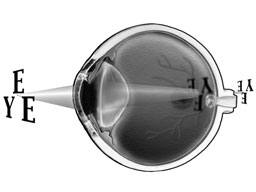 |
|---|
When you are young, the lens of your eye is soft and flexible. The lens of the eye changes its shape easily, allowing you to focus on objects both close and far away. The refractive error known as presbyopia begins to occur in most people around 40-years of age when the lens of the eye begins to lose its elasticity. It is a normal aging process that occurs in everybody which makes it difficult to focus on near objects or more difficult to read at close range and is usually corrected with bifocals or reading glasses.
You can have presbyopia in combination with myopia, hyperopia or astigmatism.
After 40 years of age, most people find it increasingly difficult to read or see clearly at close range. This condition known as presbyopia is a normal part of aging. It develops as the lens of the eye becomes less flexible and loses its ability to focus on near objects. Presbyopia should not be confused with hyperopia or farsightedness, which relates to the eyeball being too short, a feature that is present from birth.
HOW TO READ YOUR GLASSES PRESCRIPTION
The numbers that your Optometrist writes on your glasses prescription describes your refractive error. The numbers are measured in dioptres (D).
The sphere column indicates how short-sighted or long-sighted you are. If the number has a plus (+) symbol, this indicates that you are long-sighted and that you need a convex lens to correct your vision. If the number has a minus (-) symbol, this indicates that you are short-sighted and that you need a concave lens to correct your vision.
If you require reading glasses, there will be an additional number known as the ‘add’.
This always has a plus (+) symbol and has to be added to your distance prescription to calculate the strength of your reading glasses or bifocals.
Example
Sphere |
Cylinder |
Axis |
|---|---|---|
R.E.-2.75 |
-2.25 |
180˚ |
L.E. -1.50 |
-1.50 |
180˚ |
Add+2.00 |
This means that the right eye has 2.75D of short-sightedness with 2.25D of stigmatism (the axis being 180 degrees) and the left eye has 1.5D of short-sightedness with 1.5D of astigmatism (the axis being 180 degrees). This patient will need 2D extra power in the lenses for reading (the 'add').










